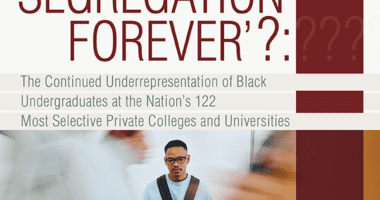Introducing New Features to College Results Online
We often hear a lot about what makes a good college, but not as much about what makes a bad college. College Results Online, our interactive tool with information for nearly every four-year college and university in the country, tries to demystify that issue by adding two new features to alert students and policymakers of colleges that may not have the best results for students.
CRO now tags colleges that have extremely low graduation rates (what we call “college dropout factories”) and colleges with little socioeconomic diversity (our “engines of inequality”). Colleges that fall in the bottom 5 percent of four-year colleges nationwide for graduation rates or low-income student enrollment will now be marked with the following symbols:
![]() College Dropout Factories: These colleges graduate less than 16 percent of their students and may not be the best option for students, especially if they are first-generation or low-income and may require additional support. These colleges should draw the attention of states and policymakers, as well as the public, which are increasingly questioning the return on investment for a college degree.
College Dropout Factories: These colleges graduate less than 16 percent of their students and may not be the best option for students, especially if they are first-generation or low-income and may require additional support. These colleges should draw the attention of states and policymakers, as well as the public, which are increasingly questioning the return on investment for a college degree.
![]() Engines of Inequality: These colleges enroll less than 16 percent of students from working-class and low-income families and are not very socioeconomically diverse. This is a flag for students from these backgrounds — and for any student seeking a culturally diverse experience in college. To prepare students for the workforce, these colleges should commit to student body diversity in all forms of the word.
Engines of Inequality: These colleges enroll less than 16 percent of students from working-class and low-income families and are not very socioeconomically diverse. This is a flag for students from these backgrounds — and for any student seeking a culturally diverse experience in college. To prepare students for the workforce, these colleges should commit to student body diversity in all forms of the word.
So why the bottom 5 percent? As described in our Tough Love report, there is a wide range in institutional performance on key metrics related to student access and student success.
Consider, for example, the range in current six-year (never mind four-year) graduation rates: 0.6 percent to 100 percent. The bottom of the pack includes colleges like:
- Paul Quinn College in Texas (0.6%),
- ITT Technical Institute-Norfolk in Virginia (2.0%)
- Auburn University-Montgomery in Alabama (5.5%)
A similar range exists for the enrollment rates of low-income students. Among the low-performers there, perhaps unsurprisingly, are some of our nation’s most exclusive colleges:
- Washington University-St. Louis in Missouri (6.5%)
- Yale University in Connecticut (11.9%)
- University of Virginia (12.2%)
This range in performance is not good for our country, and it’s not good for students. What’s needed is a bright-line, bottom-line standard — such as the bottom 5 percent — that identifies colleges that are not living up to their core public missions: ensuring access for low-income students and graduating all students. Both are important indicators of an institution’s commitment to students and the public good. And since getting a college degree has never been more important, students and families — as well as policymakers and advocates — need to know which colleges may not be the best investment. To discover which colleges don’t have strong results for students and explore higher performing options, check out our refreshed CRO.
(Learn how to navigate CRO and use its new features in this video tutorial.)









